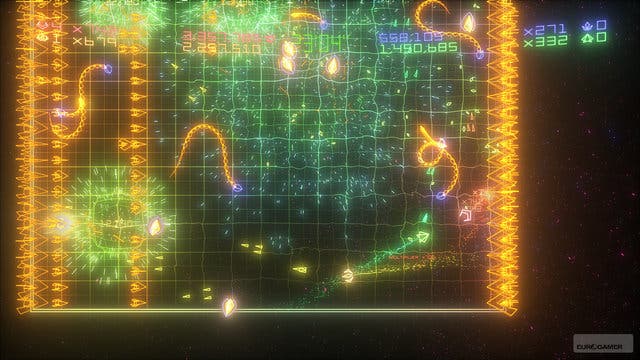Geometry Wars: Retro Explained
Bizarre's Stephen Cakebread does the maths.
Yeah, although I have to say that I do remember we spent about two weeks trying to come up with a logo for it. And all the achievement icons, oh, that was so much pain.
The first we heard about Live Arcade was when somebody at Microsoft Games sent [Bizarre boss] Martin Chudley a Live Arcade disc. We didn't hear about it until we'd started working on 360. So we hadn't really been aware of Live Arcade at all. Live Arcade 1 [for the original Xbox] wasn't built into the dash and I don't think many people knew about it, but it set the model, or at least set the ball rolling. When we heard it would be built into the dashboard [on 360] we knew it had the potential to be something big.
Well, not really...
Microsoft requested it.
We thought, well we put an Easter egg in PGR2, let's do an Easter egg for PGR3. When Microsoft came along and asked if we'd like to do a Live Arcade version, it just made absolute sense. It was interesting to get a foot in the water, to see if Live Arcade would take off.

Well, they kind of came together by just getting down and playing the game.
We did loads of iteration, we had the luxury of just taking as long as we needed to take with Geometry Wars 2. There were loads of modes that even quite near to the end, we just cut them out. Certain multiplayer modes.
Yeah, one of the multiplayer modes was an air-hockey kind of thing where you had gravity wells either side of the grid, and your ship was pulled back and forth, and the idea was to fill the opponent's gravity well up so it would explode. It was one of those things that was fun for five minutes, and then you were like... [makes non-committal noise]. It was like a Flash game.
With the toolset it was easy to get things running and try them out. We'd play it, sometimes leave it for a while and then decide whether we liked it, or what bits we liked.
We were also looking at what people were requesting - some people liked Geometry Wars but they didn't like the fact that it didn't have levels or a set progression, which is where Sequence came from. And it was nice to get something to end the game on, the last level to unlock.

In Geometry Wars 1, people would just circle all the time around the arena, and that was the optimum way to score big - you'd have a huge tail of enemies chasing after you and just pick the ones off in front of you. And while it was optimal, it wasn't particularly fun to play. I wanted to encourage people to play the game more aggressively. Making enemies drop something made the player move towards them. Initially we had it so you had to pick up 100 Geoms to multiply your score by one, but people weren't bothering to pick them up. So we had to make them really, really strong.
It was good because it didn't fix a player to a particular style of play.
We did try lots of other mechanics to achieve that, and they all felt like they were damaging the gameplay of Geometry Wars in some way. We had this weird one where you pressed a button and it flipped the grid, which was the biggest mindf*** you've ever seen. It was like two games of Geometry Wars on top of each other simultaneously...
I think the name Geoms came about because you were writing the design document at the time, and you were going to call them...
Glimmers!
And I was like, we're not calling them f***ing Glimmers.
A band took that name after we dropped it, and it's a cool band.








